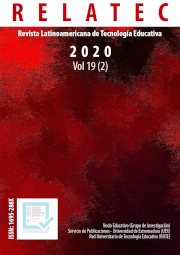The ecological quality of interactions on digital platforms in education
DOI:
https://doi.org/10.17398/1695-288X.19.2.207Keywords:
Education, Educational Technology, Educational Innovation, Digital Platforms, Reticular Ecology, Complexity, EcosystemAbstract
The emergence and evolution of Digital Platforms in different sectors of society has caused significant changes in their way of living and operating. In education, the use and construction of these platforms is a reality in continuous expansion, now enhanced by the pandemic, due to the need for physical isolation. However, in order to understand their evolution in education and the transformations it has caused in the habitation of teaching and learning, is necessary to analyze, in addition to the digital technological evolution in relation to the type of connectivity, the understanding of education implicit in it’s architecture, evidenced by the possibilities it offers for the teaching and learning processes to develop. We propose a conceptual framework that allows us to understand digital interaction platforms as a complex relational ecology that carries a specific communicative way of living. In this context, we created a typology that resulted in four main models: Platforms for providing and accessing content, Interactive Platforms, Open World Platforms and Ecological Interaction Platforms. The latter, due to its openness and because it allows for a network connection, hybrid between different entities, gives them a symbiotic «living» ecosystem character, which would allow us to name as Inventive Connective Ecosystem Platforms.
Downloads
References
Bratton, B. H. (2016). The stack: On Software and sovereignty. MIT Press.
Capra, F. (2002). The hidden connections. HarperCollins.
Castells, M. (1999). A Sociedade em Rede. São Paulo: Paz e Terra.
Di Felice, M. (2009). Paisagens pós-urbanas: o fim da experiência urbana e as formas comunicativas do habitar. Annablume.
Di Felice, M. (2017). Net-ativismo: da ação social para o ato conectivo. Paulos Editora
Dijck, J. V., Poell, T., & Wall, M. (2018). The Platform Society: public values in a connective world. Oxford University Press.
Floridi, L. (2015). The Onlife Manifesto. Springer.
Forbes, A. S. (2001). Tha lake as microcosm in C. Leveque: Ecologie, de l’ ecosysteme à la biosphere. Dunod.
Haeckel, E. (2016). Forme in evoluzione: Morfologia del vivente e psicologia cellulare. Mimesis.
Kastrup, V. (2015). A cognição contemporânea e a aprendizagem inventiva. In V. Kastrup, S. Tedesco & E. Passos (Orgs.), Políticas da Cognição (p. 91-110). Sulina.
Lévy, P. (1999). Cibercultura. Editora 34.
Schlemmer, E. (2002). AVA: Um Ambiente Virtual de convivência Interacionista Sistêmico para Comunidades Virtuais na Cultura da Aprendizagem. Tese – Programa de Pós-Graduação em Informática na Educação. Porto Alegre: UFRGS.
Schlemmer, E.; & Backes, L. (2015). Learning in Metaverses: Co-Existing in Real Virtuality. IGI Global.
Schlemmer, E. (2018). Projetos de Aprendizagem Gamificados: uma metodologia inventiva para a educação na cultura híbrida e multimodal. Revista Momento - Diálogos em Educação, 27.
Schlemmer, E. (2020). A cidade como espaço de aprendizagem: games e gamificação na constituição de espaços de convivência híbridos, multimodais, pervasivos e ubíquos para o desenvolvimento da cidadania. Relatório de Pesquisa.
Schlemmer, E.; Morgado, L. ; Moreira, J. A . (2020). Transformação Digital e Humanidades: educação e comunicação em movimento (Print Tdh). Interfaces Da Educação, 11, 764-790.
Schlemmer, E.; Moreira, A. J. M. (2020). Ampliando Conceitos para o Paradigma de Educação Digital OnLIFE. Revista Interacções, 16(54).
Tansley, A. G. (1935). The use and abuse of vegetational concepts and terms. Ecology, 16, 284-307.
Downloads
Published
Issue
Section
License
Authors who publish in this journal accept the following conditions:
1. The Author retains copyright in the article. Upon acceptance of the article, the author shall grant to the Publisher the right of first publication of the article. with the dcoument registered with the Creative Commons Attribution-NonCommercial-NoDerivative 4.0 International (CC BY-NC-ND) license, which allows to third parties to use what is published whenever they mention the authorship of the work and the first publication in this journal.
2. Authors can make other independent and additional contractual agreements for the non-exclusive distribution of the article published in this journal (eg, include it in an institutional repository or publish it in a book) provided they clearly indicate that the work was published for the first time in this journal.
3. Authors are allowed and recommended to publish their work on the Internet (for example on institutional or personal pages) before and during the review and publication process, as it can lead to productive exchanges and a greater and faster diffusion of published work (see The Effect of Open Access).









